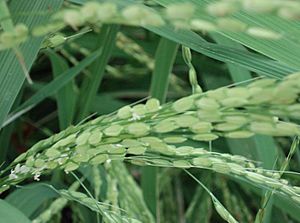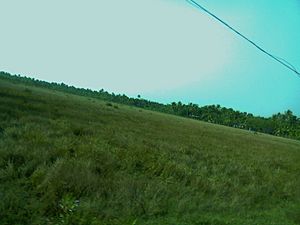Pokkali Rice facts for kids
Pokkali (Malayalam: പൊക്കാളി) is a very special type of rice. It grows in the coastal areas of Kerala, a state in South India. What makes Pokkali rice unique is its ability to grow in salty water. Farmers grow it in a natural, organic way in water-logged fields. This special rice is so famous that it has a "GI tag." This tag is like a special label that shows it comes from a specific place and has unique qualities.
Contents
How Pokkali Rice Grows
Pokkali rice is amazing because it can handle salty water. Farmers grow this rice from June to early November. During this time, the water in the fields is not too salty.
The Rice and Prawn Cycle
After the rice harvest, something else special happens. From mid-November to mid-April, the water in the fields becomes much saltier. This is when prawn farming takes over! Baby prawns swim in from the sea and nearby backwaters. They feed on the leftover parts of the rice plants.
Farmers use special gates called sluice gates to control the water. These gates help manage the flow of water into and out of the fields. The rice plants don't get any extra fertilizer or manure. Instead, they get their food from the prawns' waste and other natural bits left in the water. This makes the farming truly organic.
Growing Tall in Water
The fields where Pokkali rice grows are very fertile because of the tides. This means farmers don't need to add any fertilizers. The rice seedlings just grow naturally.
To survive in the water-filled fields, Pokkali rice plants grow very tall. They can reach up to 130-140 centimeters! But as they get older, they bend over. Only the top parts, called panicles (where the grains are), stay upright.
Harvesting the Rice
Harvesting usually happens by the end of October. Farmers only cut the top 30 centimeters of the plant, which holds the rice grains. The rest of the tall stalks are left in the water. These stalks then break down and become food for the prawns that arrive later. This is when the second part of the Pokkali farming, the prawn season, begins.
Why Pokkali Rice is Special
Pokkali rice is grown naturally, without chemicals. It is known for its unique taste. It also has a lot of protein, which is good for you.
Farmers say that Pokkali rice grains are extra large. They also believe the rice has special health benefits. In the past, fishermen would eat Pokkali rice to give them energy to stay at sea all day.



